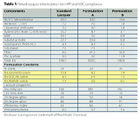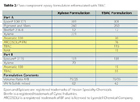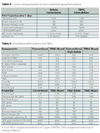With its final rule, the EPA created a new class of VOCs for low-reactivity compounds like TBAC. This new category of exempt compounds requires users to report their emissions, but does not limit their use of the solvent. Fortunately, this requirement does not create a significant reporting burden for companies, since most are already required to report their VOC emissions. It has, however, complicated the state exemption process. For example, some states that made reference to the federal definition to automatically add new exempt compounds, now have to undertake rulemaking to add TBAC.
The federal exemption last December marked the beginning of a similar and, fortunately, more expeditious process at the state level. This article attempts to bring the reader up-to-date on the current status of the TBAC exemption and provides a technical overview of the coating technologies where TBAC will likely become an important HAP and VOC compliance tool.

TBAC VOC Exemption Status
As of the date of publication, TBAC was already exempt in 28 states: Shasta County, CA; Pima County, AZ; the city of Louisville, KY; and Puerto Rico. TBAC is also VOC-exempt in Pennsylvania, but not for use in AIM (architectural and industrial maintenance) coatings. This is because the Pennsylvania Department of Environmental Protection AIM coating rule includes California's list of VOC-exempt compounds, which needs to be updated.2The status of the TBAC exemption, as of November 2005, is shown on the map in Figure 1. The states in green either exempted TBAC automatically or have already completed their VOC definition update. States in yellow will grant some form of interim relief during the rulemaking period. How this relief is granted varies from state to state, with some states simply requiring that TBAC users report their emissions as required by the federal rule, while others will allow TBAC to be used as an exempt compound only via permits or variances. The states that did not grant interim relief - Arizona, Kentucky, Michigan and Oregon - are expected to have completed their rulemaking process by early 2006.
California has also begun the process to exempt TBAC. In a recent draft Environmental Impact Assessment,3 the Cali¬fornia Air Resources Board (CARB) indicates it plans to exempt TBAC in certain consumer product categories. CARB has tied the exemption to its CONS-2 rulemaking process, which will probably not be completed until 2007. So, TBAC will probably not be available as a compliance tool for consumer product categories for another year or two.
However, in a Suggested Control Measures (SCM) for automotive refinish coatings,4 CARB suggests that the Air Quality Management districts and counties may exempt TBAC as a way to achieve mandated VOC reduction targets. CARB, the state regulatory agency, regulates only consumer products, but provides regulatory guidance to the Air Quality Management districts and counties. The districts and counties regulate VOC emissions from point sources such as auto-body repair shops and wood coating operations. State guidance comes in the form of environmental impact assessments (EIAs) and SCMs. As a result, the South Coast Air Quality Air Management District (SCAQMD) has partially exempted TBAC in its automotive coatings rule (1151).5 Other districts and counties are expected to follow the lead of SCAQMD and CARB.
VOC Policy in Canada and Europe
Canada has recently proposed strict new VOC regulations for consumer products, AIM and automotive coatings, modeled after those of CARB and the Ozone Transport Commission (OTC), a group of 13 Northeastern states with regional VOC-content limits.6 The proposed Canadian rule contains the same list of VOC-exempt compounds that will need to be updated to exempt TBAC.7 Lyondell has formally requested that Environment Canada do so. Environment Canada is considering our request and is expected to inform us shortly how it intends to manage its list of VOC-exempt compounds.European VOC regulations, on the other hand, are not based on reactivity but on volatility. Any material with a boiling point above 250 °C is considered exempt. This exemption only benefits a small number of coalescents and plasticizers used in latex or waterborne paints. Faster-evaporating solvents useful in solventborne coatings cannot be exempted under the current European rules.
Consequently, the VOC content limits for solventborne coatings in Europe tend to be higher than in the United States. This is because volatile exempt solvents such as acetone, p-chlorobenzotrifluoride (PCBTF) or TBAC are not available as compliance tools, and the lower United States limits are not technically achievable using solventborne coating technologies.

Future U.S. VOC Policy
The U.S. EPA recently issued an interim guidance document on VOC policy.8 This document encourages the states to explore alternative compliance options based on relative reactivity in addition to mass-based VOC controls. This approach was first developed by CARB for the aerosol coatings rule9 that was recently accepted by the U.S. EPA as an acceptable means to achieve SIP-mandated (State Implementation Plan) ozone reductions.10 It appropriately focuses the attention on ozone reduction rather than on VOC emission reduction. A reactivity-based VOC policy would not only provide industry with greater compliance flexibility, but it is more likely to reduce ozone levels faster and at a lower cost than the current mass-based approach.The document also states that the EPA will continue to exempt compounds with negligible reactivity based on the mass-based ethane standard when MIR (Maximum Incremental Reactivity) values11 are considered and the mole-based ethane standard when kOH values are compared. This validates the recent exemptions of acetone and TBAC and will hopefully put an end to the ‘gram vs. mole' debate. As the document states, "a comparison to ethane on a mass basis strikes the right balance between a threshold that is low enough to capture compounds that significantly affect ozone concentrations and a threshold that is high enough to exempt some compounds that may usefully substitute for more highly reactive compounds."
As the graph in Figure 2 illustrates, replacement of reactive HAP solvents like toluene, xylene and MIBK with TBAC will have a significant impact on ozone reduction from coatings. This type of substitution should be encouraged wherever possible, and a VOC policy that includes exemptions for negligibly reactive compounds and a reactivity-based compliance option is an effective way to achieve this goal.
TBAC Usage
TBAC is a fast evaporating solvent (2.8 times faster than n-BuAc) with very low water solubility (0.3%), a flash point of 40 °F, and a strong, camphor-like odor.12 Although the odor is not as objectionable as PCBTF or as strong as n-BuAc, it will probably preclude most interior architectural uses. Its low flash point will also keep it out of formulations that have a 100 °F flash point requirement. Finally, its low water solubility and fast evaporation rate will severely limit its use in most waterborne paints, especially architectural latex paints.TBAC will be used predominantly in solventborne industrial coatings, especially in the following applications: automotive refinish coatings; industrial maintenance topcoats; air-dry OEM coatings; wood lacquers and quick-dry enamels; thinners; paint gun cleanup and hand wipe degreasing.
Its use in baking enamels will be somewhat limited by its fast evaporation rate, which may cause solvent popping if the formulation does not contain enough of a good tail solvent. In general, we recommend a minimum of 30% slow solvent to complement TBAC in coatings that will be subjected to above-ambient cure temperatures.
The following formulations illustrate how TBAC can be used as a compliance tool in wood lacquers, 2K epoxy and urethane coatings, and alkyd enamels. TBAC is also a versatile VOC-exempt thinner component and a potential replacement for MEK and acetone for cleaning paint guns.

Wood Coatings
Nitrocellulose (NC) lacquers are among the oldest of paint technologies and are still used extensively in the wood furniture market because of their low cost, ease of application and repair, and unparalleled clarity and depth-of-image. However, conventional NC lacquers contain only 10-30% resin at spray viscosity and no longer comply with VOC regulations in many states.Fortunately, NC is soluble in TBAC. This means that manufacturers of wood furniture and cabinetry will once again be allowed to use low-solids NC lacquers, but without the environmental impact of the old formulations. Table 1 shows the effect of replacing MEK, xylene and n-BuAc with TBAC and PMA in a standard NC wood lacquer.
The lacquer properties were essentially unchanged. However, the VOC and HAP contents were significantly reduced. In this case, the ozone formation potential was reduced 75%, whereas the VOC reduction was only 63%. In other words, the environmental benefit exceeds the regulatory benefit. TBAC can also be used in conversion varnishes for cabinetry, including acid-catalyzed varnishes.

TBAC in Two-Component Epoxy Amine Coatings13
Two-component epoxy coatings are used extensively in industrial maintenance applications that require superior corrosion resistance. The epoxy resins are mixed with amine- or amido-functional curing agents just prior to application to give a tough, flexible and corrosion- and chemically resistant film.The most common solvents used in this type of coating are toluene and xylene because they are inexpensive and do not react with the epoxy resins or amine curing agents. Unfortunately both solvents produce large amounts of ozone when emitted to the atmosphere, especially in polluted urban environments (Figure 2), and are listed as hazardous air pollutants. Glycol ethers and ketones are also used for their polarity and excellent solubility properties. One class of solvents that is almost never used in epoxies is esters. That's because most esters react with the amine curatives to form amides. When the amine crosslinker reacts with the solvent, it is no longer available to crosslink the epoxy and the crosslink density of the coating decreases, affecting its cure speed, toughness and durability.
However, TBAC is unique because the ester group is protected by the bulky tert-butyl group. It should, therefore, be less susceptible to reactions with amines and polyamides. The stability of these curing agents in TBAC, n-BuAc and toluene was measured at 60 ∞C for 30 days, which corresponds to one year of storage under normal conditions. The percent amine retained after 30 days in TBAC was comparable to that in xylene and was much higher than that which remained in n-BuAc (Figure 3).

These results confirm that TBAC can replace a large portion of xylene in two-component epoxy polyamide coating formulations with no effect on the coating performance, but with a large decrease in the VOC (45%) and HAP (80%) contents of the coating. The MIR reduction was 59%, providing another example where the ozone reduction benefit exceeds the reduction in VOC content. This illustrates the value of exempting negligibly reactive compounds such as TBAC.

TBAC in 2K Urethane Coatings
Two-component (2K) urethane coatings are used in a variety of applications where durability, flexibility and low VOCs are required. These applications include automotive refinish topcoats and maintenance coatings for bridges and concrete, as well as aircraft paints. Solvents used in these coatings must be aprotic and have low water contents so as to not react with the isocyanate crosslinker.Acetone and PCBTF are currently the primary compliance solvents for low-VOC 2K urethane coatings and equipment cleanup. The weight ratio of acetone to PCBTF in automotive refinish formulations in California is on the order of 1:2. Because of the much higher density of PCBTF (11.2 lbs/gal), the volume ratio is closer to 1:1. TBAC is likely to replace both solvents because of its better performance and lower cost. If TBAC replaces this solvent blend throughout California, we estimate a decrease of ~600,000 lbs/year in solvent emitted and a decrease of ~200,000 lbs/year in ozone formed.
TBAC is an active solvent for both acrylic polyols and isocyanate crosslinkers. Several suppliers of acrylic polyols are now offering their products in TBAC. Isocyanate suppliers have evaluated the stability of their most common crosslinkers in TBAC and found it to be comparable to toluene. TBAC is also being considered as a replacement for acetone/PCBTF blends in zero-VOC thinners for 2K urethanes. The formulations shown in Table 4 illustrate how TBAC can be used to replace the fast solvents in a 2K urethane to lower the VOC content of the coating without affecting the final film properties.
In these formulations, the fast solvent n-BuAc was replaced with TBAC. The slow solvent MAK was retained in the formulation. This substitution caused the VOC content to decrease by over one lb/gal in both formulations with no effect on the final coating properties. This decrease results because the slow solvent is the last to leave the coating and has the greatest impact on the coating's appearance, performance and durability.

TBAC in Alkyd Coatings
Some suppliers of alkyd resins have also begun to offer their industrial resins in TBAC or TBAC-slow solvent blends. TBAC is potentially a useful compliance tool for industrial baking and air-dry enamels that are based on alkyd technologies, especially short-oil and modified alkyd resins, such as phenolic- and silicone-modified alkyds. There are several reasons for this.First, the industrial market is more tolerant of coatings with flammable or odorous solvents than the architectural market, which relies predominantly on odorless mineral spirits. Second, industrial medium- and short-oil alkyd resins are typically more viscous and require higher solvent levels than their long-oil counterparts for the do-it-yourself or contractor-applied architectural markets. These lower solids technologies are the most impacted by VOC and HAP regulations that also limit the contents of HAP-listed toluene and xylene. Consequently, the industrial market is the most likely to benefit from TBAC as a compliance tool and to tolerate its odor and flash point.
The alkyd formulations in Table 5 are based on recently published work from Southern Clay Products14 and illustrate the effect of using TBAC as a let-down solvent and resin solvent on the VOC content of medium-oil alkyd formulations. Using TBAC as a let-down solvent decreased the VOC content by almost one lb/gal, but using a higher-solids alkyd resin already cut in TBAC, such as Beckosol 11-081-E2,15 can help further reduce the VOC content.
Conclusions
VOC-exempt TBAC provides formulators with a practical and cost-effective tool for HAP and VOC compliance. Unlike other VOC-exempt solvents, TBAC has an intermediate evaporation rate and broad solvency for coatings resins, making it a more useful formulation tool for a variety of VOC-compliant industrial coatings as well as thinners and cleanup. Coating uses include automotive and industrial maintenance coatings, wood lacquers and varnishes, and a variety of OEM coatings for metal, paper and plastics.By the end of 2007, we expect most states and possibly Canada will have exempted TBAC from VOC regulations. This will allow coatings manufacturers to offer lower-VOC solventborne coatings for applications where low-solvent technologies cannot be used or do not meet performance requirements.
Ultimately, U.S. and Canadian VOC policies may make even greater use of relative reactivity as an alternative compliance option. In that event, current exempt, low-reactivity solvents like TBAC will continue to be useful formulating tools for suppliers of solventborne coatings, inks, adhesives and cleaners.
For further information, visit www.tbac.com or email tbac@lyondell.com.
References
- www.epa.gov/ttncaaa1/t1/fr_notices/ tbac.pdf
- www.pacode.com/secure/data/025/chapter130/ subchapCtoc.html
- www.arb.ca.gov/research/reactivity/ tbac0.pdf
- www.arb.ca.gov/coatings/autorefin/scm/7-05clean.pdf
- www.aqmd.gov/rules/proposed/r1151/ par1151-091505.pdf
- www.ec.gc.ca/nopp/voc/en/bkg.cfm
- www.ec.gc.ca/nopp/voc/en/defn.cfm
- www.epa.gov/ttn/oarpg/t1/memoranda/ 27601interimguidvoc.pdf
- www.arb.ca.gov/regact/conspro/aerocoat/ aerocoat.htm
- www.epa.gov/fedrgstr/EPA-AIR/2005/September/ Day-13/a18016.htm
- http://pah.cert.ucr.edu/~carter/reactdat. htm#data
- www.tbac.com
- www.lyondell.com/html/products/techlit/ PC166.pdf
- www.paint.org/thebench/current_issue.htm volume 2, issue 7. August 18, 2005.
- Beckosol 10-081 E2 is a developmental resin supplied by Reichhold Chemical Company.


Report Abusive Comment